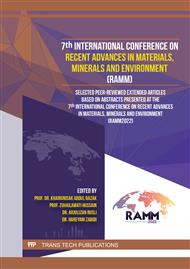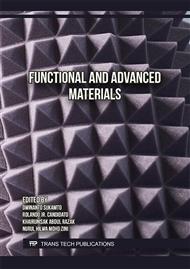[1]
R. Purwar and R. Sachan, Thermoresponsive shape memory polymers for smart textiles. LTD, 2020.
DOI: 10.1016/b978-0-12-820257-9.00003-5
Google Scholar
[2]
W. Shen, W. Wu, C. Liu, Y. Wang, and X. Zhang, "Thermal conductivity enhancement of PLA/TPU/BN composites by controlling BN distribution and annealing treatment," Plast. Rubber Compos., vol. 49, no. 5, p.204–213, 2020.
DOI: 10.1080/14658011.2020.1729657
Google Scholar
[3]
H. Chen et al., "Thermal conductivity of polymer-based composites: Fundamentals and applications," Prog. Polym. Sci., vol. 59, p.41–85, 2016.
DOI: 10.1016/j.progpolymsci.2016.03.001
Google Scholar
[4]
M. Lei, Z. Chen, H. Lu, and K. Yu, "Recent progress in shape memory polymer composites: Methods, properties, applications and prospects," Nanotechnol. Rev., vol. 8, p.327–351, 2019.
DOI: 10.1515/ntrev-2019-0031
Google Scholar
[5]
J. Jiang, S. Yang, L. Li, and S. Bai, "High thermal conductivity polylactic acid composite for 3D printing: Synergistic effect of graphene and alumina," Polym. Adv. Technol., p.1–9, 2020.
DOI: 10.1002/pat.4858
Google Scholar
[6]
Z. Lule, J. Yang, and J. Kim, "A Study on the Thermal Conductivity of Poly(lactic acid)/Alumina Composites: The Effect of the Filler Treatment," J. Nanosci. Nanotechnol., vol. 20, no. 1, p.229–238, 2019.
DOI: 10.1166/jnn.2020.17260
Google Scholar
[7]
Y. Du et al., "Flexible n-type tungsten carbide/polylactic acid thermoelectric composites fabricated by additive manufacturing," Coatings, vol. 8, no. 1, 2018.
DOI: 10.3390/coatings8010025
Google Scholar
[8]
M. Murariu and P. Dubois, "PLA composites: From production to properties," Adv. Drug Deliv. Rev., vol. 107, p.17–46, 2016.
DOI: 10.1016/j.addr.2016.04.003
Google Scholar
[9]
R. Umamaheswari, S. Manavalan, S. M. Chen, S. Chinnapaiyan, T. W. Chen, and R. Jothi Ramalingam, "Facile synthesis and characterization of erbium oxide (Er2O3) nanospheres embellished on reduced graphene oxide nanomatrix for trace-level detection of a hazardous pollutant causing Methemoglobinaemia," Ultrason. Sonochem., vol. 56, no. January, p.422–429, 2019.
DOI: 10.1016/j.ultsonch.2019.02.023
Google Scholar
[10]
S. S. Nafee, T. A. Hamdalla, and A. A. A. Darwish, "Studies of the morphology and optical properties of nano erbium oxide embedded in PMMA matrix," Opt. Laser Technol., vol. 129, no. April, p.106282, 2020.
DOI: 10.1016/j.optlastec.2020.106282
Google Scholar
[11]
M. N. Alghamdi, "Thermoplastic composite system using polymer blend and fillers," J. King Saud Univ. - Eng. Sci., no. xxxx, 2021.
DOI: 10.1016/j.jksues.2020.12.009
Google Scholar
[12]
N. F. Alias, H. Ismail, and M. K. A. Wahab, "Properties of polyvinyl alcohol/palm kernel shell powder biocomposites and their hybrid composites with halloysite nanotubes," BioResources, vol. 12, no. 4, p.9103–9117, 2017.
DOI: 10.15376/biores.12.4.9013-9117
Google Scholar
[13]
K. Majeed, M. Al Ali AlMaadeed, and M. M. Zagho, "Comparison of the effect of carbon, halloysite and titania nanotubes on the mechanical and thermal properties of LDPE based nanocomposite films," Chinese J. Chem. Eng., vol. 26, no. 2, p.428–435, 2018.
DOI: 10.1016/j.cjche.2017.09.017
Google Scholar
[14]
F. H. Azizul Rahim et al., "Thermo-responsive shape memory properties based on polylactic acid and styrene-butadiene-styrene block copolymer," J. Appl. Polym. Sci., vol. 138, no. 39, p.51000, May 2021.
DOI: 10.1002/app.51000
Google Scholar
[15]
F. H. Azizul Rahim and A. Rusli, "Rheological and thermoresponsive shape memory properties of polylactic acid (PLA) and styrene-butadiene-styrene (SBS) copolymer blends," J. Polym. Res., vol. 29, no. 11, 2022.
DOI: 10.1007/s10965-022-03296-9
Google Scholar
[16]
F. H. A. Rahim and A. Rusli, "Rheological and Thermoresponsive Shape Memory Properties of Polylactic Acid (PLA) and Styrene-Butadiene-Styrene (SBS) Copolymer Blends," J. Polym. Res., no. 11/2022, 2022.
DOI: 10.1007/s10965-022-03296-9
Google Scholar
[17]
M. Kim, S. Jang, S. Choi, J. Yang, J. Kim, and D. Choi, "Analysis of shape memory behavior and mechanical properties of shape memory polymer composites using thermal conductive fillers," Micromachines, vol. 12, no. 9, 2021.
DOI: 10.3390/mi12091107
Google Scholar
[18]
C. M. Yakacki, N. S. Satarkar, K. Gall, R. Likos, and J. Z. Hilt, "Shape-Memory Polymer Networks with Fe3O4 Nanoparticles for Remote Activation," J. Appl. Polym. Sci., vol. 112, p.3166–3176, 2009.
DOI: 10.1002/app.29845
Google Scholar
[19]
N. Burger, A. Laachachi, M. Ferriol, M. Lutz, V. Toniazzo, and D. Ruch, "Review of thermal conductivity in composites: Mechanisms, parameters and theory," Prog. Polym. Sci., vol. 61, p.1–28, 2016.
DOI: 10.1016/j.progpolymsci.2016.05.001
Google Scholar
[20]
A. Amirkiai et al., "Microstructural design for enhanced mechanical and shape memory performance of polyurethane nanocomposites: Role of hybrid nanofillers of montmorillonite and halloysite nanotube," Appl. Clay Sci., vol. 198, no. June, p.105816, 2020.
DOI: 10.1016/j.clay.2020.105816
Google Scholar
[21]
K. Kornaus, A. Gubernat, D. Zientara, P. Rutkowski, and L. Stobierski, "Mechanical and thermal properties of tungsten carbide-graphite nanoparticles nanocomposites," Polish J. Chem. Technol., vol. 18, no. 2, p.84–88, 2016.
DOI: 10.1515/pjct-2016-0033
Google Scholar
[22]
P. R. Kubade, P. Tambe, and H. B. Kulkarni, "Morphological, thermal and mechanical properties of 90/10 (WT %/ WT %) PP/ABS blends and their polymer nanocomposites," Adv. Compos. Lett., vol. 26, no. 6, p.182–188, 2017.
DOI: 10.1177/096369351702600602
Google Scholar
[23]
N. F. Alias and H. Ismail, "Effects of Partial Replacement of Eggshell Powder by Halloysite Nanotubes on the Properties of Polyvinyl Alcohol Composites," IOP Conf. Ser. Mater. Sci. Eng., vol. 374, no. 1, 2018.
DOI: 10.1088/1757-899X/374/1/012032
Google Scholar
[24]
J. Plattier, L. Benyahia, M. Dorget, F. Niepceron, and J. F. Tassin, "Viscosity-induced filler localisation in immiscible polymer blends," Polymer (Guildf)., vol. 59, p.260–269, 2015.
DOI: 10.1016/j.polymer.2014.12.044
Google Scholar
[25]
F. Fenouillot, P. Cassagnau, and J. C. Majesté, "Uneven distribution of nanoparticles in immiscible fluids: Morphology development in polymer blends," Polymer (Guildf)., vol. 50, no. 6, p.1333–1350, 2009.
DOI: 10.1016/j.polymer.2008.12.029
Google Scholar
[26]
M. Johar, K. Z. Zarkasi, F. Hashim, and A. Rusli, "Thermal, mechanical, rheological and morphological properties of compatible poly(lactic acid)/ethylene vinyl acetate blends," Prog. Rubber, Plast. Recycl. Technol., vol. 38, no. 2, p.172–187, Apr. 2022.
DOI: 10.1177/14777606221085988
Google Scholar
[27]
M. F. Brigatti, E. Galán, and B. K. G. Theng, Structure and Mineralogy of Clay Minerals, vol. 5. 2013.
Google Scholar



